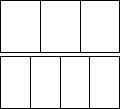Larger fractions II
| a) |
Which is the larger fraction out of 15 and 17?
Show or explain how you know this.
|
|
|
b)
|
Which is the larger fraction out of 34 and 45?
Show or explain how you know this.
|
|
|
c)
|
Which is the larger fraction out of 76 and 89?
Show or explain how you know this.
|
| Y6 (11/2005) | ||
| a) |
1/5 and explanation involving any 1 of the following:
|
moderate |
| b) |
4/5 and explanation involving any 1 of the following:
|
difficult |
| c) |
7/6 and explanation involving any 1 of the following:
|
difficult |
Based on a representative sample of 173 Year 6 students.
NOTES:
- Accept the use of cross multiplying to find common multiples to show which fraction is larger, but ask if students can explain it or show it in another way as well. Cross multiplying to find common factors could be a learned procedure and not necessarily indicate understanding of what they are doing.
- Each of the questions is optimally solved using a different strategy: partitioning knowledge, difference to a whole, and more or less than a whole respectively. Encourage students to look at the range of different strategies used by the group/class and discuss which are more efficient or accurate, and identify which best suits the fractions being compared. By trying to use the same strategy for a different question an insufficient explanation may result.
| Common response | Likely misconception | |
|
a) b) c) |
1/7 > 1/5 because 7 is bigger than 5. 4/5 > 3/4 because 4 & 5 are bigger than 3 & 4. 8/9 > 7/6 because 8 & 9 are bigger than 7 & 6. |
Applying rules for whole numbers, and not recognising that a fraction is a rational number (a/b). |
| c) | 8/9 s larger because 8 × 9 > 7 × 6. | Students do not understand the relationship between the numerator and denominator in a fraction. They know that it is about the relationship between the numbers but think it is based on multiplication |
| a) - c) |
"[fraction] is bigger" (repeating the answer in the first part) |
Students do not understand what is required for an explanation. |
|
b) c) |
3/4 7/6 ...because the lower the denominator the bigger the pieces. |
Students do not understand that to compare non-unit fractions they must consider the relationship between the top and the bottom number. This simple rule for partitioning does not allow for this. |
| a) - c) | Insufficient diagram showing only the largest fraction (similar to repeating the answer in the first part). | Students do not understand that to compare two fractions both must be represented to offer a valid comparison. |
| c) | 4/5 and 3/4 are both the same/equal. | Students know they are one "piece" from 1 but are not taking into account the size of the pieces. |
| c) | "Can't do" 7/6 - not a proper fraction. | Students do not know that fractions can be greater than 1. |
Students who think that "the larger the numbers the larger the fraction" are likely to be applying these rules based on their experiences with whole numbers and do not recognise that fractions are rational numbers and therefore a different kind of number. This is one of the least sophisticated misconceptions around comparing fractions.
Students with this misconception will state 1/7 > 1/5 , 4/5 > 3/4 and 8/9 > 7/6).
NOTE: 4/5 > 3/4 would be correct, but for incorrect reasons.
Get students to partition shapes (also sets and amounts) into parts and justify their answers by explaining, showing (with equipment), or drawing. They should recognise that one piece is a unit fraction of the whole. Encourage students to think about how they could construct each fraction (e.g., partition then build up) and then find common ground on which to compare them. When comparing fractions it may help to have students consider it in this way:

- Use two rectangle shapes the same size;
- Partition one into 7 parts and the other into 5 parts;
- Lay these next to each other and discuss which unit fraction is larger.
Students can further explore other non-unit fractions using these two denominators, e.g., 3/5 and 3/7 , or 3/5 and 2/7 (both these examples have the fractions on opposite sides of a half). Finish this exercise by removing the images and encourage students to solve similar comparison problems by visualising the fractions in their head.
Students who do not recognise 7/6 as a fraction need to explore a wider range of fractions, including improper fractions. For example, how much of a pizza does each person get if they share 3 pizzas amongst 2 people? Answer: 3/2 or 1 1/2 each. The wording "a pizza" is important here as they would always get 1/2 of "the pizza"). Point out that 3/2 is a fraction and compare back to 7/6 . Ask if they can they come up with a pizza story that 7/6 could be the answer, and what this would look like.
Students who answered with an insufficient explanation, or simply repeated that one was larger without further elaboration, need to have a "sufficient" explanation modelled and made explicit to them. A summary of what makes an explanation sufficient is:
- specific details;
- appropriate use of examples;
- justification;
- clarity to another reader.
Further teacher and peer modelling of a sufficient explanation should also help supplement their understanding of what is needed in an explanation. Then address their ideas about constructing each fraction and finding common ground on which to compare them (as described above).

